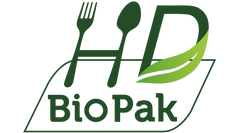
When you buy plastic take-out containers from us at HD Bio Packaging, you will likely find a recycling symbol with the number inside on the bottom of each to-go container. Or you will find an abbreviated code that we put in the Material section. What does it mean, and how should you use it to better manage your take-out services? Here’s a quick guide for your clarification.
Types of plastics
So far, there are nearly a hundred kinds of known plastic materials. The function of plastic can be divided into three types: general plastic, engineering plastics, and special plastics. If we take a closer look at the bottom of plastic bottles (for example, plastic bottles for food and laundry detergent), we will notice a triangular recycling symbol consisting of three arrows and the numbers 1-7 therein.
This code is developed by the Society of Plastics Industry (SPI) for the types of plastics used, and the numbers 1-7 represent the type of resin used in plastics. With this number, the identification of plastic types in waste recycling has become simple and easy, and recycling costs have been significantly reduced. Many countries around the world today have adopted this SPI identification scheme. Let’s check what stories have been told by these little numbers inside of each “Chasing arrow”.

-
Polyethylene terephthalate - #01 PET

Heat-resistant to 70 ℃, best suitable for warm or cold food. When containers made of PET are loaded with high-temperature food, or heated in the oven, which will easily cause deformation and extract substances that are harmful to the human body.
-
High-density Polyethylene - #02 HDPE

PE can also be divided into HDPE (high-density polyethylene) and LDPE (low-density polyethylene), with the difference in density, resulting in the performance difference. HDPE is a rigid, tough plastic that offers good chemical resistance and low moisture absorption. It is strong yet lightweight. HDPE milk jug that weighs 2oz can carry a gallon of milk.
Products made of PE can be reused after careful cleaning, but these containers are usually not easy for cleaning, which may result in bacteria growth.
-
Polyvinyl Chloride - #03 PVC

This material is easy to produce harmful substances under high temperatures. Currently, this material has been less used for food packaging.
-
low-density polyethylene – #04 LDPE

Most plastic bags are made of polyethylene (PE). PE cling film encounters temperatures exceeding 110 ℃ will melt, which leaves some plastic agents that the human body cannot decompose. Make sure to check for a microwaveable symbol before putting it into the microwave over.
-
polypropylene - #05 PP

Polypropylene is the only plastic that can be put into the microwave oven among the seven kinds and can be easily reused after cleaning. Things that need to be noted are that some take-out boxes are made of No. 5 PP, but the lid is made of No. 1 PE. Since No. 1 PE cannot withstand high temperatures, it cannot be put into the microwave oven together with the box. So, remove the lid before putting the plastic box into the microwave oven, or consult us today to make sure.
Polypropylene also played a big role during this year's pandemic: disposable medical gowns and disposable masks are mostly made of non-woven fabric spun from polypropylene.
-
Polystyrene - #06 PS

Polystyrene is both heat and cold-resistant and can withstand up to 60-70 degrees. But it can not be put into the microwave oven. And it is also not recommended for acidic or alkaline juices (such as orange juice), as it will decompose polystyrene which studies show may cause cancer. Therefore, it is best used for cold food like salad, sushi, or cold drinks.
-
Other Plastic- 07 Other

If there are no numbers on the plastic packaging, it will generally be treated as #07. The #07 category was designed for polycarbonate and all “Other” plastic initially, but now a new generation of compostable plastics made from polymers like Corn-starch is also treated as #07. These compostable plastics have the initials “PLA” on the bottom near the recycling symbol. Some may also say “Compostable.” Therefore, the recycling protocols can vary for this category and can be confusing to customers.
What is a sustainable takeout solution?
With no doubt, the most sustainable option is to use reusable products for on-site dining. Studies clearly show that reusable products have the lowest environmental impacts. However, due to the pandemic and let’s just be honest, everyone needs to order take-out food once sometimes. Therefore, how to choose the right packaging is essential for both restaurants and customers. Here’s a quick guide from Zero Waste Victoria you may find helpful:
What we can offer at HD Bio Packaging?
The guide shows that #1 and #5 can be used for recyclable plastic containers. #5 plastic is suitable for either dry, wet, hot, or cold food. Polypropylene is also accepted at most Canadian recycling facilities. Here at HD Bio Packaging, we supply the most high-end #5 microwaveable heat-safe plastic container for all food service businesses. Other than that, we also supply the following to help you with building a sustainable take-out solution for your business.
- #1 PET cold cups
- Sugarcane/paper containers
- Aluminum containers with cardboard lids
- Uncoated wooden utensils
Consult us today for products that meet your local plastic recyclers’ guidelines.


